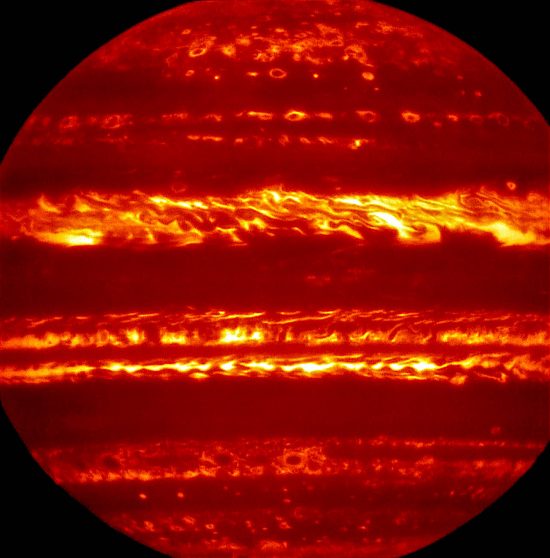
New false-color infrared image of Jupiter. Credit: ESO/L. Fletcher
Jul 4, 2016
Juno enters Jupiter space.
The latest mission to Jupiter began on August 5, 2011 when NASA launched the Juno spacecraft from Cape Canaveral, Florida. After flying past the orbit of Mars, the spacecraft returned for a gravity assist from Earth on October 9, 2013 and then headed out to deep space. Arrival at Jupiter is scheduled for today, July 4, 2016.
Jupiter is the largest planet. With an equatorial diameter of 142,984 kilometers, it is so large that all of the other planets could fit comfortably inside. Jupiter rotates so fast that a day lasts only 9.925 hours, causing its equatorial diameter to be 9275 kilometers more than the distance between its poles.
There are also bands of radiation, similar to the Van Allen radiation belts that surround Earth, except that the radiation emitted by Jupiter is thousands of times greater, and would be instantly fatal to any organism without heavy shielding. Juno’s sensitive electronics are enclosed within a titanium shell, so that the energetic particles trapped around Jupiter will not interfere with its processing and signaling power.
The most energetic of the trapped particles are electrons that radiate at radio frequencies. In 1955 that radiation led to the discovery that Jupiter had a magnetic field. It should be noted, however, that the maverick scientist, Immanuel Velikovsky, predicted Jupiter’s magnetic field in October of 1953.
The Galileo spacecraft discovered electricity around Jupiter from the moon Io as it revolves through Jupiter’s electromagnetic fields. Electric power greater than 2 trillion watts is dissipated between them. The electric charge flow travels along Jupiter’s magnetic field, creating lightning in the planet’s upper atmosphere, as well as intense aurorae at the poles. The Hubble Space Telescope released a video of the aurorae, timed to coincide with Juno’s arrival.
Jupiter’s aurorae are becoming more active, with bursts of extreme ultraviolet light detected. It is presumed by planetary scientists that the auroral flares are “…pulsed reconnections of the magnetic field at the planet’s dayside magnetopause…” Or, magnetic reconnection.
The solar wind is thought to interact with Jupiter’s magnetic field, “stretching” it like a rubber band. As the theory goes, when field lines “snap back” they explode, converting some “magnetic energy” into heat and light.
As discussed in a previous Picture of the Day, how that energy is released is not known. However, it is clear that space scientists are reversing cause (electricity) and effect (magnetic fields). They downplay or deny the importance of electrical processes.
Retired Professor of Electrical Engineering Donald Scott’s admonitions about magnetic reconnection should be kept in mind when the electromagnetic nature of aurorae, in general, is invoked:
- Magnetic field lines are only convenient concepts, nothing more. They are not loci or contours of constant magnetic flux density (field strength). They just indicate the field’s direction. In regions where they are close together the field is stronger than where they are widely separated.
- Therefore, sketching magnetic field lines can help us visualize the shape and strength of magnetic fields. They can help us to sketch the net result (vector sum) if and when two or more fields interact (are superimposed on each other).
- We can only draw magnetic field lines (in cases not involving permanent ferromagnetic magnets) by considering the electric currents that create those fields.
- Magnetic lines of force do not actually exist in three-dimensional space anymore than lines of latitude or longitude do.
- If a field changes from one instant to another, we cannot use “streaming video” to watch a given line move and change shape. This is because we must redraw a complete set of lines at each instant. It isn’t the same line that has moved it is the field that has changed. The two sets of lines describe the field at those two different times.
- Magnetic lines of force do not move any more than lines of longitude do. A determined unwillingness to recognize this fact has led to the idea that lines can move toward each other, touch, merge, and then release energy. This last notion, if applied to circles of longitude that come together and “merge” at Earth’s poles, could be proposed as causing gravitational energy releases at those locations.
The electrical interaction between Jupiter and its moons, as well as between Jupiter and the Sun, means that it and they are charged bodies and are not electrically neutral. Jupiter is in a dynamic electrical relationship with the Sun and it is now known that charged particles from the Sun power planetary aurorae.
Stephen Smith












